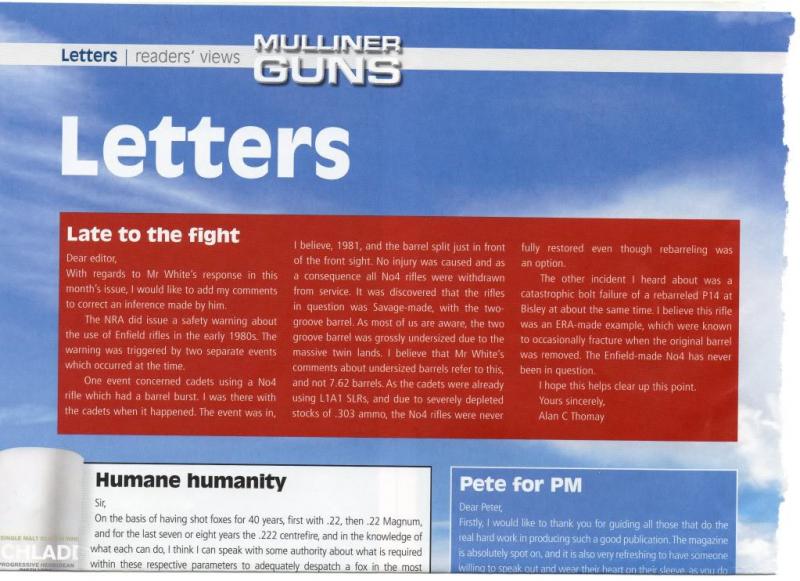I plan to write back in response to Mr Whites "riposte" i the April issue of the magazine.
I will be using the information provided by
Peter Laidler
, and the up-to-date information from 'strangely'.
Here is my proposed letter :
Dear Sir
In the letter pages of the April issue, Mr Chris White issued a “Riposte” in response to the several letters concerning his article “Wet Weather Drill” (March issue).
Yet again Mr. White is perpetuating internet rumours and myths without taking the trouble to actually investigate and substantiate his comments.
His two main arguments seem to revolve around :
a) “…. The MOD placing an embargo on cadets shooting No4’s ….”
b) “… the NRA issued Safety warning ….”
Having investigated both of these statements it is now clear that they are both gross misinterpretations of fact, so what is the actual truth behind them ?
a) The rumour of the Mod ‘banning’ the use of No4 Lee Enfield’s has come about as a result of a cadet being injured by an “Exploding” rifle.
The facts are as follows :
“The Board of Enquiry after the event found out what happened and it was this. The rifles that were 'live' were taken onto the firing point and a couple of other 'live - serviceable' rifles were at the back of the firing point together with a few DP rifles, used for what is called 'background activity' One of the rifles on the firing point wouldn't fire so the instructor stood behind the firer took it off him, cleared it and shouted to one of the Cadet NCO's at the rear.... 'bring me another rifle over.....' which he did.
What neither of them did was to check that the 'new' rifle was serviceable....., and in this case, it wasn't because it had a big hole through the barrel, top to bottom. BUT, the BOLT was serviceable, unlike the bolt in the rifle that had failed to fire, The first round it fired resulted in the accident where the Cadet lost a couple of fingers.
The Board of Enquiry established that prior to the actual shooting, half the group had sat around in a circle and started to clean the rifles and bolts while the other half had filled some Bren magazines and cleaned/oiled the Bren guns. Then they changed over and the Bren filling half finished off cleaning and oiling the rifles and assembled them.
Unfortunately, due to 'lack of adult supervision', a DP bolt with a welded up bolt face and therefore no striker protrusion was placed into a service rifle. This rifle wouldn't fire. But because of this, a DP rifle went onto the firing point with a serviceable bolt and fired”.
As you can see the failure was not due to the rifle, but due to a massive failure of safety rules and supervision.
b) “.. the NRA Safety warning …” Indeed the NRA did issue such a warning, but (unlike Mr White) have actually undertaken investigations and have now withdrawn the warning. The comments now published in the ‘Journal’ say :
“After further consideration of all factors influencing safety of these conversions and consultation with the Birmingham Proof Master, the following advice must be adhered to in respect of the use of Enfield No 4 conversions:
•
Conversions retaining their original Enfield barrel or a replacement barrel as manufactured by RSAF Enfield are safe to use with commercial CIP approved ammunition, which complies with a MAWP of 4150 bar, loaded with any weight of bullet, providing they carry a valid proof mark, and are still in the same condition as when submitted for proof.
• Conversions fitted with any other make of barrel, (such as Ferlach, Maddco, Krieger etc) should be checked by a competent gunsmith to determine the throat diameter of the chamber/barrel fitted before use.
• Conversions, where the throat diameter is less than the CIP specification of 0.311” but not smaller than 0.3085” must not be used with ammunition which exceeds 3650 Bar MAWP when fired in a SAAMI/CIP pressure barrel.
•
Conversions which have been checked and found to comply with Rule 150 may safely be used with any ammunition supplied by the NRA including the 155 grain Radway Green Cartridge, 155 grain RUAG Cartridge or any other commercial CIP Approved cartridges loaded with bullets of any weight provided that the ammunition pressure does not exceed 3650 Bar when measured in a CIP standard barrel”.
Surely it is now time to put this argument “to bed” and for Mr White to stand up and admit he has been proliferating unsubstantiated rumours.
Yours faithfully
















 PM
PM













